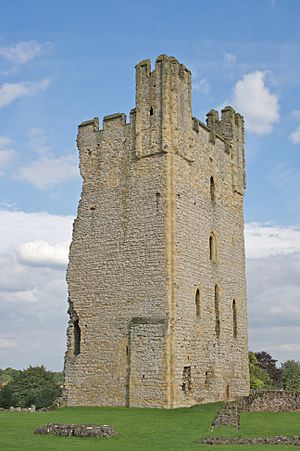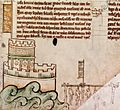Slighting facts for kids
Slighting means purposely damaging an important building. This was often done to castles during wars, especially in the Middle Ages. Castles were very strong and belonged to powerful people.
Kings and queens sometimes ordered castles to be slighted. They did this to punish people who fought against them. Imagine someone building a huge castle without the king's permission! The king might order them to take it apart. Also, if a castle owner thought their castle might be captured by enemies, they might damage it themselves. This made sure the enemies couldn't use it.
Contents
Why Were Castles Sighted?
Slighting was a way to show power and control. If a castle was slighted, it meant the owner had lost a battle or upset the ruler. It also stopped enemies from using the castle as a base.
Punishment and Control
When a king or queen won a war, they often slighted the castles of those who lost. This was a clear message: "Don't rebel against me!" It also made sure the castle couldn't be used again to fight the king. For example, after the English Civil War, many castles were slighted by the winning side, Parliament. They wanted to prevent anyone from using these strongholds against them in the future.
Preventing Enemy Use
Sometimes, a castle owner would slight their own castle. This happened if they knew they were about to lose it to an enemy. By damaging the walls or towers, they made the castle useless. This way, the enemy couldn't move in and use it as their own fort.
Famous Sighted Castles
Many castles we see as ruins today were slighted a long time ago. They were not just left to fall apart. Instead, people deliberately broke them down.
Castles from the English Civil War
The English Civil War (1642-1651) saw many castles slighted. Two famous examples are Corfe Castle and Kenilworth Castle.
- Corfe Castle in Dorset was a very strong castle. After a long siege, it was captured by Parliament in 1646. They then slighted it, leaving it in ruins.
- Kenilworth Castle in Warwickshire was also slighted after the war. These castles were so badly damaged that they were never fully rebuilt. They stand today as reminders of this period in history.
Other Historical Slighting Events
Slighting happened in other times too.
- After the siege of Bedford Castle in 1224, King Henry III ordered the castle to be slighted. The soldiers who defended it were even punished.
- Newark Castle in Nottinghamshire shows clear signs of slighting. Gunpowder was used there, which left big craters in the walls.
Images for kids
-
Corfe Castle in Dorset was slighted in 1646 during the English Civil War. Parliament slighted or proposed to slight more than 100 buildings, including castles, town walls, abbeys, and houses.
-
Each method of destruction leaves a distinctive trace. At Newark Castle in Nottinghamshire the use of gunpowder left a crater damage pattern.
-
After the siege of Bedford Castle in 1224, Henry III had the garrison executed and the castle slighted, as illustrated by Matthew Paris.






